Urbanization Impacts the Physicochemical Characteristics and Abundance of Fecal Markers and Bacterial Pathogens in Surface Water
Abstract
1. Introduction
2. Materials and Methods
2.1. Study Locations
2.2. Field Sampling
2.3. Physicochemical Analyses
2.4. Microbiological Analyses
2.4.1. Culture-Dependent Methods
2.4.2. Culture-Independent Methods (qPCR)
2.5. Statistical Analyses
3. Results
3.1. Variation in Physicochemical Parameters
3.2. Variation in Microbiological Parameters
3.2.1. Culture-Dependent Microbiological Parameters
3.2.2. Detection and Quantification of Fecal Markers
3.2.3. Frequency of Detection and Abundance of Genes of Bacterial Pathogens
4. Discussion
5. Conclusions
Supplementary Materials
Author Contributions
Funding
Acknowledgments
Conflicts of Interest
References
- United Nations. World Urbanization Prospects: The 2018 Revision; Department of Economic and Social Affairs, United Nations: New York, NY, USA, 2018. [Google Scholar]
- National Bureau of Statistics of China (NBSC). National Statistics Yearbook 2018; China Statistics Press: Beijing, China, 2018; [In Chinese].
- UN-HABITAT. World Cities Report 2016—Urbanization and Development: Emerging Futures; United Nations Human Settlements Programme, UN-HABITAT: Nairobi, Kenya, 2016. [Google Scholar]
- De Sherbinin, A.; Schiller, A.; Pulsipher, A. The vulnerability of global cities to climate hazards. Environ. Urban. 2007, 19, 39–64. [Google Scholar] [CrossRef]
- Shao, M.; Tang, X.; Zhang, Y.; Li, W. City clusters in China: Air and surface water pollution. Front. Ecol. 2006, 4, 353–361. [Google Scholar] [CrossRef]
- Zhu, Y.-G.; Ioannidis, J.P.A.; Li, H.; Jones, K.C.; Martin, F.L. Understanding and Harnessing the Health Effects of Rapid Urbanization in China. Environ. Sci. Technol. 2011, 45, 5099–5104. [Google Scholar] [CrossRef] [PubMed]
- Chen, Y.; Zhang, Z.; Du, S.; Shi, P.; Tao, F.; Doyle, M. Water quality changes in the world’s first special economic zone, Shenzhen, China. Water Resour. Res. 2011, 47. [Google Scholar] [CrossRef]
- Zhang, W.; Li, H.; Li, Y. Spatio-temporal dynamics of nitrogen and phosphorus input budgets in a global hotspot of anthropogenic inputs. Sci. Total Environ. 2019, 656, 1108–1120. [Google Scholar] [CrossRef]
- Jiang, Y. China’s water security: Current status, emerging challenges and future prospects. Environ. Sci. Policy 2015, 54, 106–125. [Google Scholar] [CrossRef]
- Zhu, Y.; Price, O.R.; Kilgallon, J.; Qi, Y.; Tao, S.; Jones, K.C.; Sweetman, A.J. Drivers of contaminant levels in surface water of China during 2000–2030: Relative importance for illustrative home and personal care product chemicals. Environ. Int. 2018, 115, 161–169. [Google Scholar] [CrossRef]
- Prasad, M.B.; Maddox, M.C.; Sood, A.; Kaushal, S.; Murtugudde, R. Nutrients, chlorophyll and biotic metrics in the Rappahannock River estuary: Implications of urbanisation in the Chesapeake Bay watershed, USA. Mar. Freshw. Res. 2014, 65, 475–485. [Google Scholar] [CrossRef]
- Goel, P.; Saxena, A.; Singh, D.S.; Verma, D. Impact of Rapid Urbanization on Water Quality Index in Groundwater Fed Gomati River, Lucknow, India. Curr. Sci. 2018, 114, 650–654. [Google Scholar] [CrossRef]
- Yu, D.; Shi, P.; Liu, Y.; Xun, B. Detecting land use-water quality relationships from the viewpoint of ecological restoration in an urban area. Ecol. Eng. 2013, 53, 205–216. [Google Scholar] [CrossRef]
- Carle, M.V.; Halpin, P.N.; Stow, C.A. Patterns of watershed urbanization and impacts on water quality. JAWRA J. Am. Water Resour. Assoc. 2005, 41, 693–708. [Google Scholar] [CrossRef]
- Shen, Z.; Hou, X.; Li, W.; Aini, G. Relating landscape characteristics to non-point source pollution in a typical urbanized watershed in the municipality of Beijing. Landsc. Urban Plan. 2014, 123, 96–107. [Google Scholar] [CrossRef]
- Chen, X.; Zhou, W.; Pickett, S.T.A.; Li, W.; Han, L.; Lin, Y.-P. Spatial-Temporal Variations of Water Quality and Its Relationship to Land Use and Land Cover in Beijing, China. Int. J. Environ. Public Health 2016, 13, 449. [Google Scholar] [CrossRef]
- Zhang, L.; Gao, S.; Wei, B.; Li, Y.; Li, H.; Wang, L.; Ye, B. Effects of Urbanization on Rural Drinking Water Quality in Beijing, China. Sustainability 2017, 9, 461. [Google Scholar] [CrossRef]
- Griffith, J.F.; Cao, Y.; McGee, C.D.; Weisberg, S.B. Evaluation of rapid methods and novel indicators for assessing microbiological beach water quality. Water Res. 2009, 43, 4900–4907. [Google Scholar] [CrossRef]
- Jamieson, R.; Joy, D.M.; Lee, H.; Kostaschuk, R.; Gordon, R. Transport and deposition of sediment-associated Escherichia coli in natural streams. Water Res. 2005, 39, 2665–2675. [Google Scholar] [CrossRef]
- Ahmed, W.; Sritharan, T.; Palmer, A.; Sidhu, J.P.S.; Toze, S. Evaluation of Bovine Feces-Associated Microbial Source Tracking Markers and Their Correlations with Fecal Indicators and Zoonotic Pathogens in a Brisbane, Australia, Reservoir. Appl. Environ. Microbiol. 2013, 79, 2682–2691. [Google Scholar] [CrossRef]
- Field, K.G.; Samadpour, M. Fecal source tracking, the indicator paradigm, and managing water quality. Water Res. 2007, 41, 3517–3538. [Google Scholar] [CrossRef]
- Domingo, J.W.S.; Bambic, D.G.; Edge, T.A.; Wuertz, S. Quo vadis source tracking? Towards a strategic framework for environmental monitoring of fecal pollution. Water Res. 2007, 41, 3539–3552. [Google Scholar] [CrossRef]
- Haramoto, E.; Osada, R. Assessment and application of host-specific Bacteroidales genetic markers for microbial source tracking of river water in Japan. PLoS ONE 2018, 13, e0207727. [Google Scholar] [CrossRef]
- Hlavsa, M.C.; Roberts, V.A.; Kahler, A.M.; Hilborn, E.D.; Mecher, T.R.; Beach, M.J.; Wade, T.J.; Yoder, J.S. Outbreaks of Illness Associated with Recreational Water—United States, 2011–2012. Morb. Mortal. Wkly. 2015, 64, 668–672. [Google Scholar]
- Medeiros, J.; Araújo, L.; Da Silva, V.; Diniz, C.; Cesar, D.; Del’Duca, A.; Coelho, C. Characterization of the microbial community in a lotic environment to assess the effect of pollution on nitrifying and potentially pathogenic bacteria. Braz. J. Boil. 2014, 74, 612–622. [Google Scholar] [CrossRef]
- Mao, F.; Liu, Z.; Zhou, W.; Huang, J.; Li, Q. The research and application of spatial information technology in cultural heritage conservation—Case study on Grand Canal of China. Int. Arch. Photogramm. Remote Sens. Spat. Inf. Sci. 2008, 38, 999–1006. [Google Scholar]
- Wang, L.; Shen, J.; Chung, C.K.L. City profile: Suzhou—A Chinese city under transformation. Cities 2015, 44, 60–72. [Google Scholar] [CrossRef]
- Suzhou Statistics Bureau. Suzhou Statistical Yearbook 2016; China Statistics Press: Beijing, China, 2016; [In Chinese].
- Suzhou Statistics Bureau. Suzhou Statistical Yearbook 2017; China Statistics Press: Beijing, China, 2017; [In Chinese].
- Wang, J.; Soininen, J.; Zhang, Y.; Wang, B.; Yang, X.; Shen, J. Contrasting patterns in elevational diversity between microorganisms and macroorganisms. J. Biogeogr. 2011, 38, 595–603. [Google Scholar] [CrossRef]
- American Public Health Association (APHA). Standard Methods for the Examination of Water and Wastewater, 21st ed.; American Public Health Association: Washington, DC, USA, 2005. [Google Scholar]
- Reasoner, D.J.; Geldreich, E.E. A new medium for the enumeration and subculture of bacteria from potable water. Appl. Environ. Microbiol. 1985, 49, 1–7. [Google Scholar]
- Lange, B.; Strathmann, M.; Osmer, R. Performance validation of chromogenic coliform agar for the enumeration of Escherichia coli and coliform bacteria. Lett. Appl. Microbiol. 2013, 57, 547–553. [Google Scholar] [CrossRef]
- Geldreich, E.E.; Clark, H.F.; Huff, C.B.; Best, L.C. Fecal-coliform-organism medium for the membrane filter technique. J. Am. Water Works Assoc. 1965, 57, 208–214. [Google Scholar] [CrossRef]
- Oster, R.J.; Wijesinghe, R.U.; Haack, S.K.; Fogarty, L.R.; Tucker, T.R.; Riley, S.C. Bacterial Pathogen Gene Abundance and Relation to Recreational Water Quality at Seven Great Lakes Beaches. Environ. Sci. Technol. 2014, 48, 14148–14157. [Google Scholar] [CrossRef]
- Green, H.C.; Dick, L.K.; Gilpin, B.; Samadpour, M.; Field, K.G. Genetic markers for rapid PCR-based identification of gull, Canada goose, duck, and chicken fecal contamination in water. Appl. Environ. Microbiol. 2012, 78, 503–510. [Google Scholar] [CrossRef]
- Green, H.C.; Haugland, R.A.; Varma, M.; Millen, H.T.; Borchardt, M.A.; Field, K.G.; Walters, W.A.; Knight, R.; Sivaganesan, M.; Kelty, C.A.; et al. Improved HF183 Quantitative Real-Time PCR Assay for Characterization of Human Fecal Pollution in Ambient Surface Water Samples. Appl. Environ. Microbiol. 2014, 80, 3086–3094. [Google Scholar] [CrossRef]
- Kildare, B.J.; Leutenegger, C.M.; McSwain, B.S.; Bambic, D.G.; Rajal, V.B.; Wuertz, S. 16S rRNA-based assays for quantitative detection of universal, human-, cow-, and dog-specific fecal Bacteroidales: A Bayesian approach. Water Res. 2007, 41, 3701–3715. [Google Scholar] [CrossRef]
- Vadde, K.K.; McCarthy, A.J.; Rong, R.; Sekar, R. Quantification of Microbial Source Tracking and Pathogenic Bacterial Markers in Water and Sediments of Tiaoxi River (Taihu Watershed). Front. Microbiol. 2019, 10, 10. [Google Scholar] [CrossRef]
- Fujikoshi, Y. Two-way ANOVA models with unbalanced data. Discret. Math. 1993, 116, 315–334. [Google Scholar] [CrossRef]
- Ahmed, W.; Harwood, V.; Nguyen, K.; Young, S.; Hamilton, K.; Toze, S. Utility of Helicobacter spp. associated GFD markers for detecting avian fecal pollution in natural waters of two continents. Water Res. 2016, 88, 613–622. [Google Scholar] [CrossRef]
- Cao, Y.; Raith, M.R.; Smith, P.D.; Griffith, J.F.; Weisberg, S.B.; Schriewer, A.; Sheldon, A.; Crompton, C.; Amenu, G.G.; Gregory, J.; et al. Regional Assessment of Human Fecal Contamination in Southern California Coastal Drainages. Int. J. Environ. Public Health 2017, 14, 874. [Google Scholar] [CrossRef]
- Paul, M.J.; Meyer, J.L. Streams in the urban landscape. Annu. Rev. Ecol. Syst. 2001, 32, 333–365. [Google Scholar] [CrossRef]
- Wang, X.; Han, J.; Xu, L.; Zhang, Q. Spatial and seasonal variations of the contamination within water body of the Grand Canal, China. Environ. Pollut. 2010, 158, 1513–1520. [Google Scholar]
- United States Geological Survey (USGS). pH and Water. Available online: https://water.usgs.gov/edu/ph.html (accessed on 8 August 2018).
- Ministry of Environmental Protection of People’s Republic of China (MEP). Environmental Quality Standards for Surface Water: GB 3838–2002; MEP: Beijing, China, 2002; [In Chinese].
- Farrell-Poe, K. Water Quality & Monitoring; College of Agriculture and Life Sciences, University of Arizona: Tucson, AZ, USA, 2005. [Google Scholar]
- De Sousa, D.N.; Mozeto, A.A.; Carneiro, R.L.; Fadini, P.S. Electrical conductivity and emerging contaminant as markers of surface freshwater contamination by wastewater. Sci. Total Environ. 2014, 484, 19–26. [Google Scholar] [CrossRef]
- United States Environmental Protection Agency (US EPA). Monitoring and Assessing Water Quality - Volunteer Monitoring. Available online: http://water.epa.gov/type/rsl/monitoring/vms511.cfm (accessed on 17 January 2017).
- Minnesota Pollution Control Agency (MPCA). Nutrients: Phosphorus, Nitrogen Impact on Water Quality. Water Quality/Impaired Waters #3.22. May 2008. Available online: https://www.pca.state.mn.us/sites/default/files/wq-iw3-22.pdf (accessed on 17 January 2017).
- Li, H.; Wang, C.; Huang, X.; Hug, A. Spatial Assessment of Water Quality with Urbanization in 2007–2015, Shanghai, China. Remote Sens. 2018, 10, 1024. [Google Scholar] [CrossRef]
- Liu, C.; Huang, T.; Chen, L.; Tao, H. Recent Trends in Wastewater Flow and Pollutant Load Resulting from Urbanization in Shanghai. Environ. Res. 2014, 86, 433–444. [Google Scholar] [CrossRef]
- Zhou, T.; Wu, J.; Peng, S. Assessing the effects of landscape pattern on river water quality at multiple scales: A case study of the Dongjiang River watershed, China. Ecol. Indic. 2012, 23, 166–175. [Google Scholar] [CrossRef]
- Eduful, M.; Shively, D. Perceptions of urban land use and degradation of water bodies in Kumasi, Ghana. Habitat Int. 2015, 50, 206–213. [Google Scholar] [CrossRef]
- Sun, N.; Yearsley, J.; Baptiste, M.; Cao, Q.; Lettenmaier, D.P.; Nijssen, B. A spatially distributed model for assessment of the effects of changing land use and climate on urban stream quality. Hydrol. Process. 2016, 30, 4779–4798. [Google Scholar] [CrossRef]
- Haller, L.; Amedegnato, E.; Poté, J.; Wildi, W. Influence of Freshwater Sediment Characteristics on Persistence of Fecal Indicator Bacteria. Water Air Soil Pollut. 2009, 203, 217–227. [Google Scholar] [CrossRef]
- Doyle, M.P.; Erickson, M.C. Closing the Door on the Fecal Coliform Assay. Microbe 2006, 1, 162–163. [Google Scholar] [CrossRef][Green Version]
- Glińska-Lewczuk, K.; Gołaś, I.; Koc, J.; Gotkowska-Płachta, A.; Harnisz, M.; Rochwerger, A. The impact of urban areas on the water quality gradient along a lowland river. Environ. Monit. Assess. 2016, 188, 624. [Google Scholar] [CrossRef] [PubMed]
- Santiago-Rodriguez, T.M.; Toranzos, G.A.; Arce-Nazario, J.A. Assessing the microbial quality of a tropical watershed with an urbanization gradient using traditional and alternate fecal indicators. J. Water Health 2016, 14, 796–807. [Google Scholar] [CrossRef]
- Kapoor, V.; Pitkänen, T.; Ryu, H.; Elk, M.; Wendell, D.; Santo Domingo, J.W. Distribution of human-specific bacteroidales and fecal indicator bacteria in an urban watershed impacted by sewage pollution, determined using RNA-and DNA-based quantitative PCR assays. Appl. Environ. Microbiol. 2015, 81, 91–99. [Google Scholar] [CrossRef]
- Ohad, S.; Vaizel-Ohayon, D.; Rom, M.; Guttman, J.; Berger, D.; Kravitz, V.; Pilo, S.; Huberman, Z.; Kashi, Y.; Rorman, E. Microbial Source Tracking in Adjacent Karst Springs. Appl. Environ. Microbiol. 2015, 81, 5037–5047. [Google Scholar] [CrossRef] [PubMed]
- Kim, J.Y.; Lee, H.; Lee, J.E.; Chung, M.-S.; Ko, G.P. Identification of Human and Animal Fecal Contamination after Rainfall in the Han River, Korea. Microbes Environ. 2013, 28, 187–194. [Google Scholar] [CrossRef] [PubMed]
- Kirs, M.; Kisand, V.; Wong, M.; Caffaro-Filho, R.A.; Moravcik, P.; Harwood, V.J.; Yoneyama, B.; Fujioka, R.S. Multiple lines of evidence to identify sewage as the cause of water quality impairment in an urbanized tropical watershed. Water Res. 2017, 116, 23–33. [Google Scholar] [CrossRef] [PubMed]
- Molina, M.; Hunter, S.; Cyterski, M.; Peed, L.A.; Kelty, C.A.; Sivaganesan, M.; Mooney, T.; Prieto, L.; Shanks, O.C. Factors affecting the presence of human-associated and fecal indicator real-time quantitative PCR genetic markers in urban-impacted recreational beaches. Water Res. 2014, 64, 196–208. [Google Scholar] [CrossRef]
- Zimmer-Faust, A.G.; Thulsiraj, V.; Marambio-Jones, C.; Cao, Y.; Griffith, J.F.; Holden, P.A.; Jay, J.A. Effect of freshwater sediment characteristics on the persistence of fecal indicator bacteria and genetic markers within a Southern California watershed. Water Res. 2017, 119, 1–11. [Google Scholar] [CrossRef] [PubMed]
- Fernandez, H.; Villanueva, M.P.; Mansilla, I.; Gonzalez, M.; Latif, F. Arcobacter butzleri and A. cryaerophilus in human, animals and food sources, in southern Chile. Braz. J. Microbiol. 2015, 46, 145–147. [Google Scholar] [CrossRef] [PubMed]
- Lee, C.; Agidi, S.; Marion, J.W.; Lee, J. Arcobacter in Lake Erie Beach Waters: An Emerging Gastrointestinal Pathogen Linked with Human-Associated Fecal Contamination. Appl. Environ. Microbiol. 2012, 78, 5511–5519. [Google Scholar] [CrossRef] [PubMed]
- Hausdorf, L.; Neumann, M.; Bergmann, I.; Sobiella, K.; Mundt, K.; Fröhling, A.; Schlüter, O.; Klocke, M. Occurrence and genetic diversity of Arcobacter spp. in a spinach-processing plant and evaluation of two Arcobacter-specific quantitative PCR assays. Syst. Appl. Microbiol. 2013, 36, 235–243. [Google Scholar] [CrossRef]
- Prouzet-Mauléon, V.; Labadi, L.; Bouges, N.; Ménard, A.; Mégraud, F. Arcobacter butzleri: Underestimated Enteropathogen. Emerg. Infect. Dis. 2006, 12, 307–309. [Google Scholar] [CrossRef]
- Ma, K.; Deng, Y.; Bai, Y.; Xu, D.; Chen, E.; Wu, H.; Li, B.; Gao, L. Rapid and simultaneous detection of Salmonella, Shigella, and Staphylococcus aureus in fresh pork using a multiplex real-time PCR assay based on immunomagnetic separation. Food Control 2014, 42, 87–93. [Google Scholar] [CrossRef]
- Beutin, L.; Krüger, U.; Krause, G.; Miko, A.; Martin, A.; Strauch, E. Evaluation of Major Types of Shiga Toxin 2e-Producing Escherichia coli Bacteria Present in Food, Pigs, and the Environment as Potential Pathogens for Humans. Appl. Environ. Microbiol. 2008, 74, 4806–4816. [Google Scholar] [CrossRef]
- Swift, C.; Best, E.L.; Powell, E.J.; Grant, K.A.; Frost, J.A. Applicability of a rapid duplex real-time PCR assay for speciation of Campylobacter jejuni and Campylobacter colidirectly from culture plates. FEMS Microbiol. Lett. 2003, 229, 237–241. [Google Scholar]
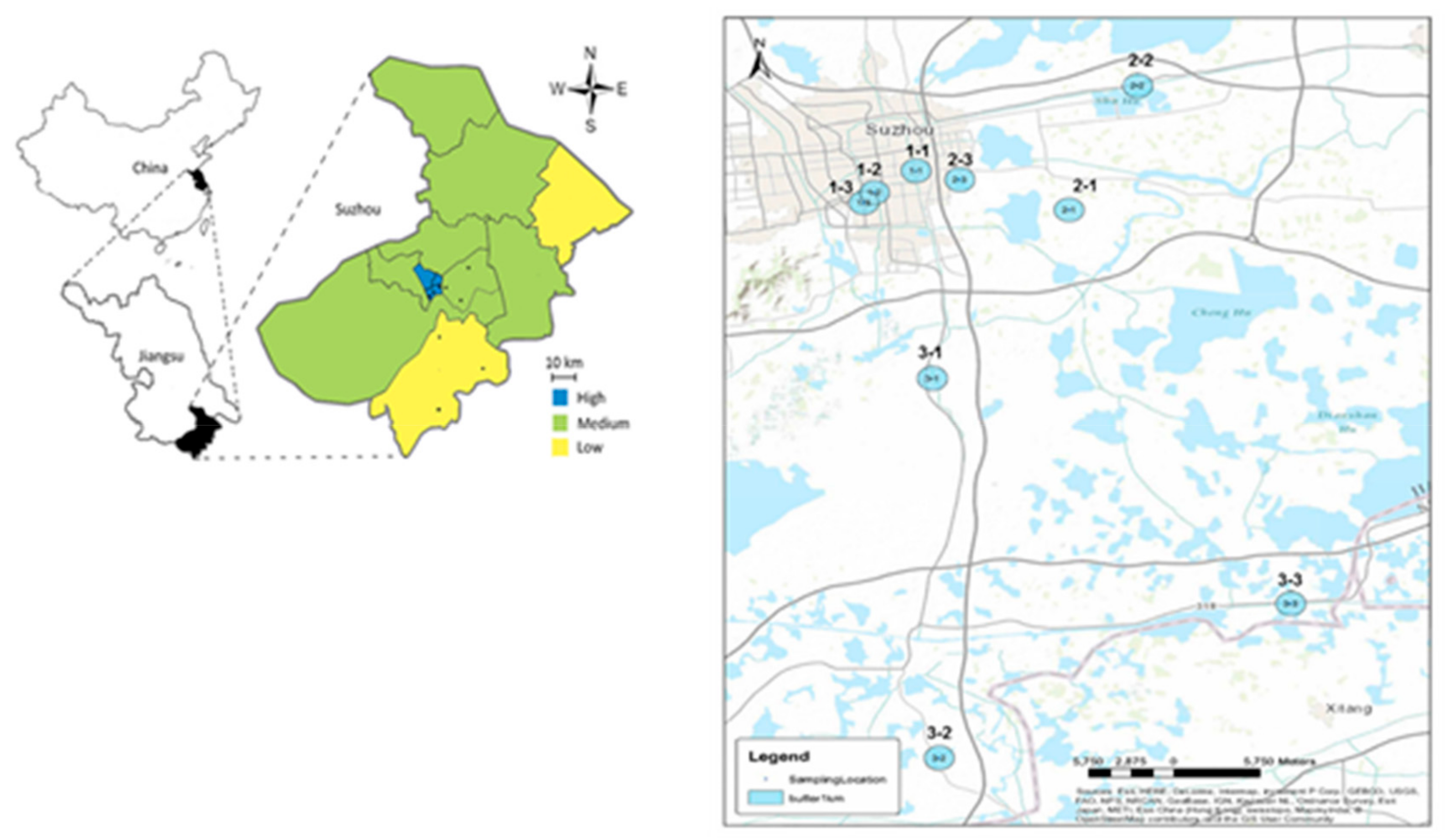
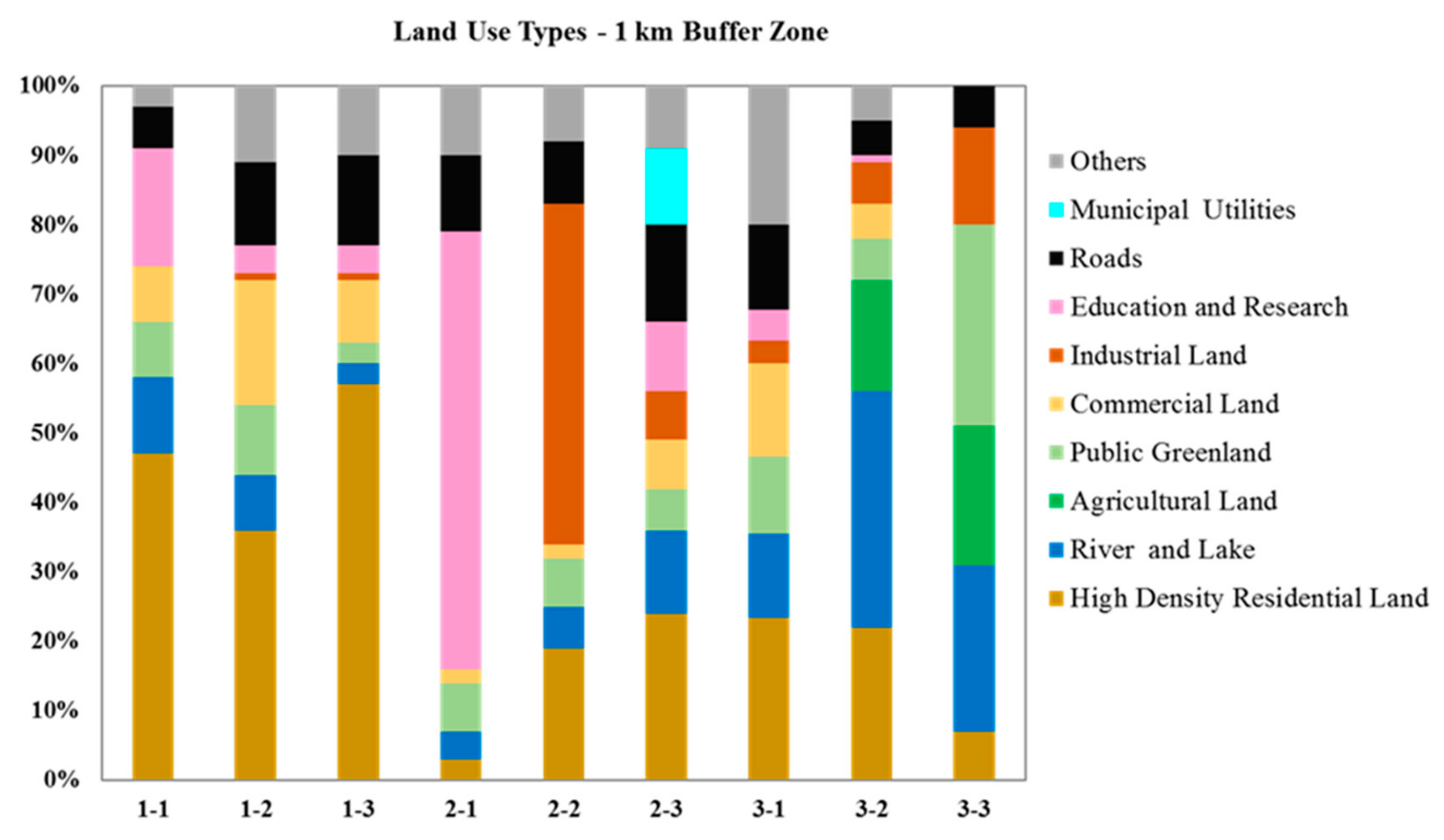
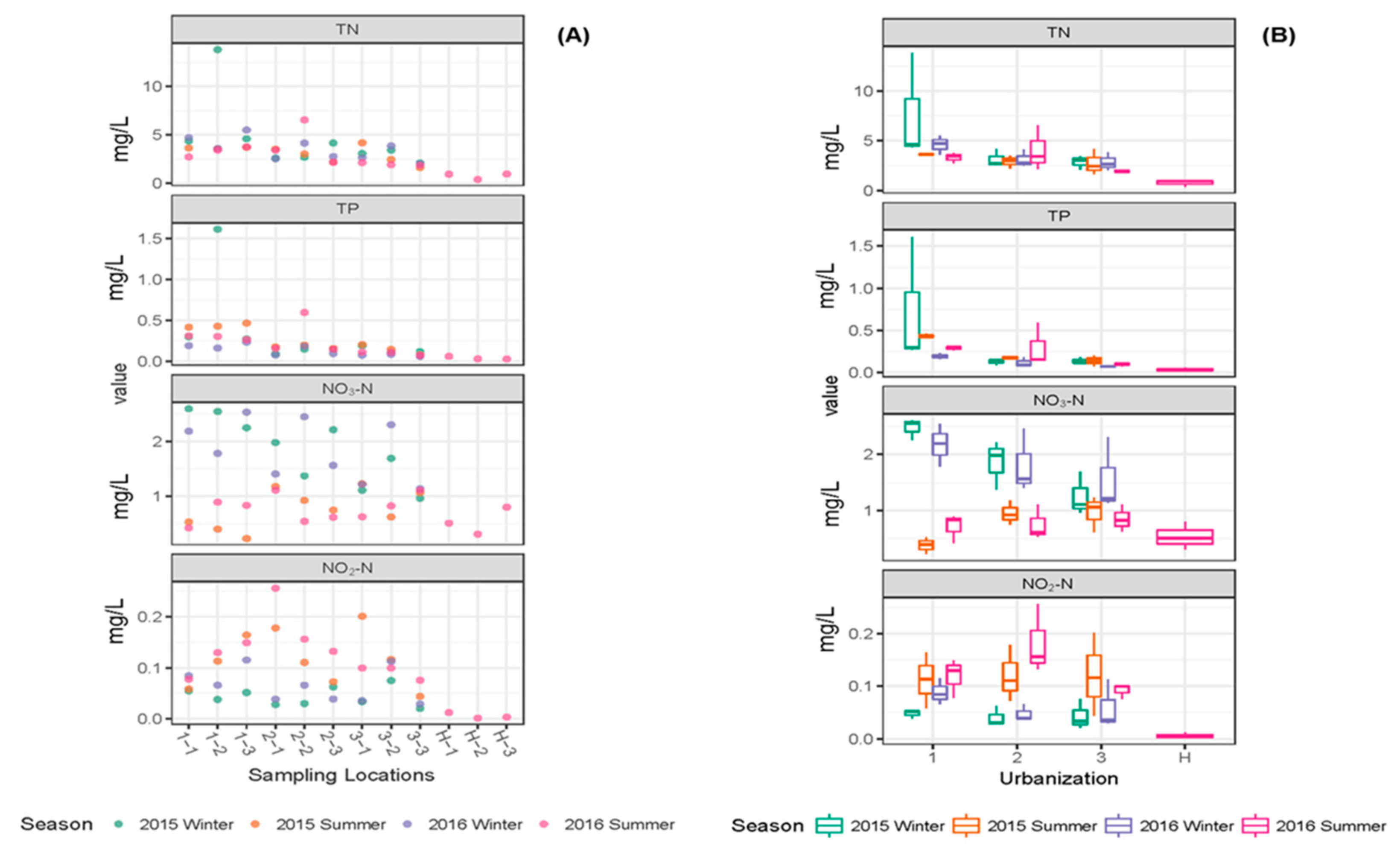
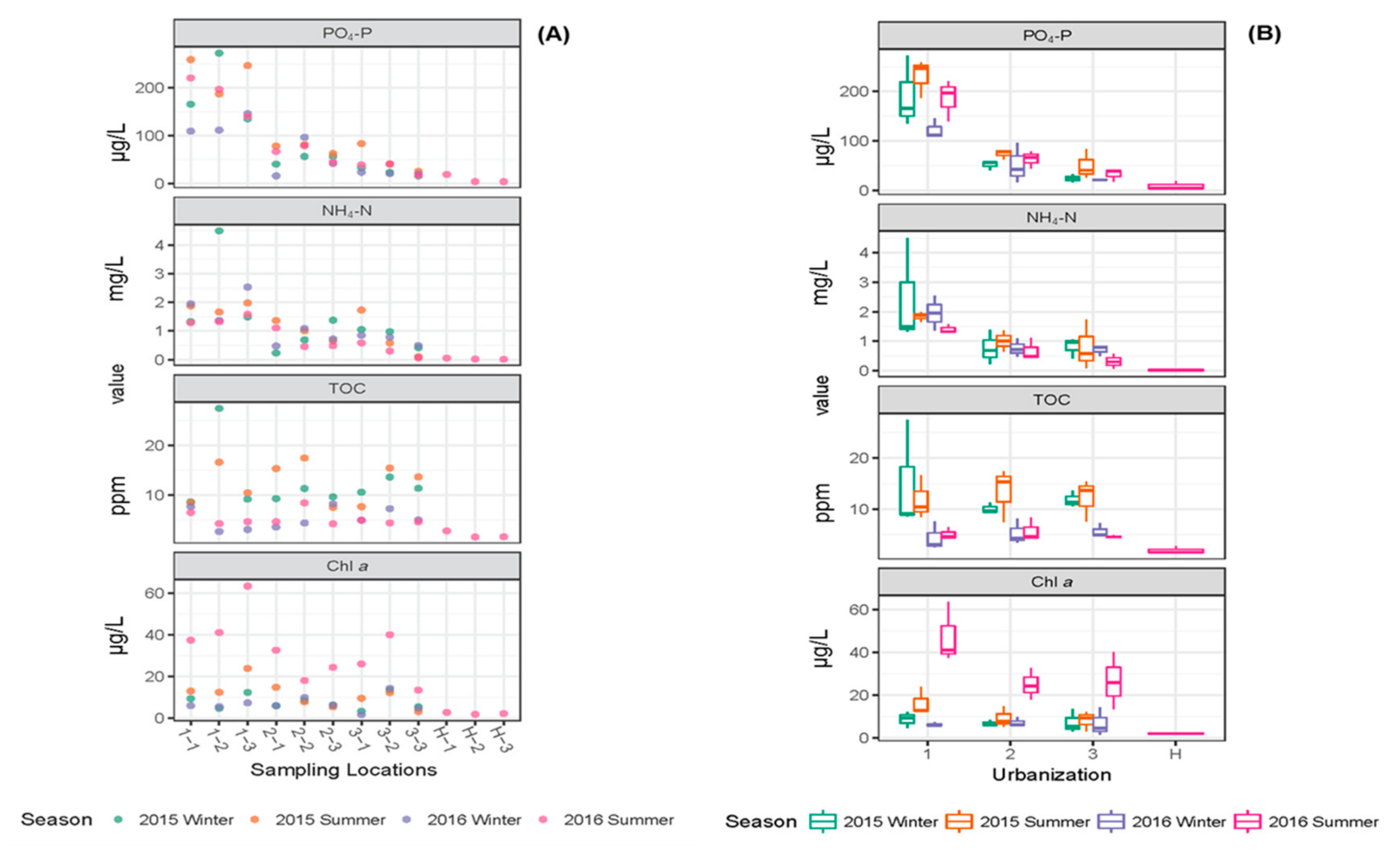
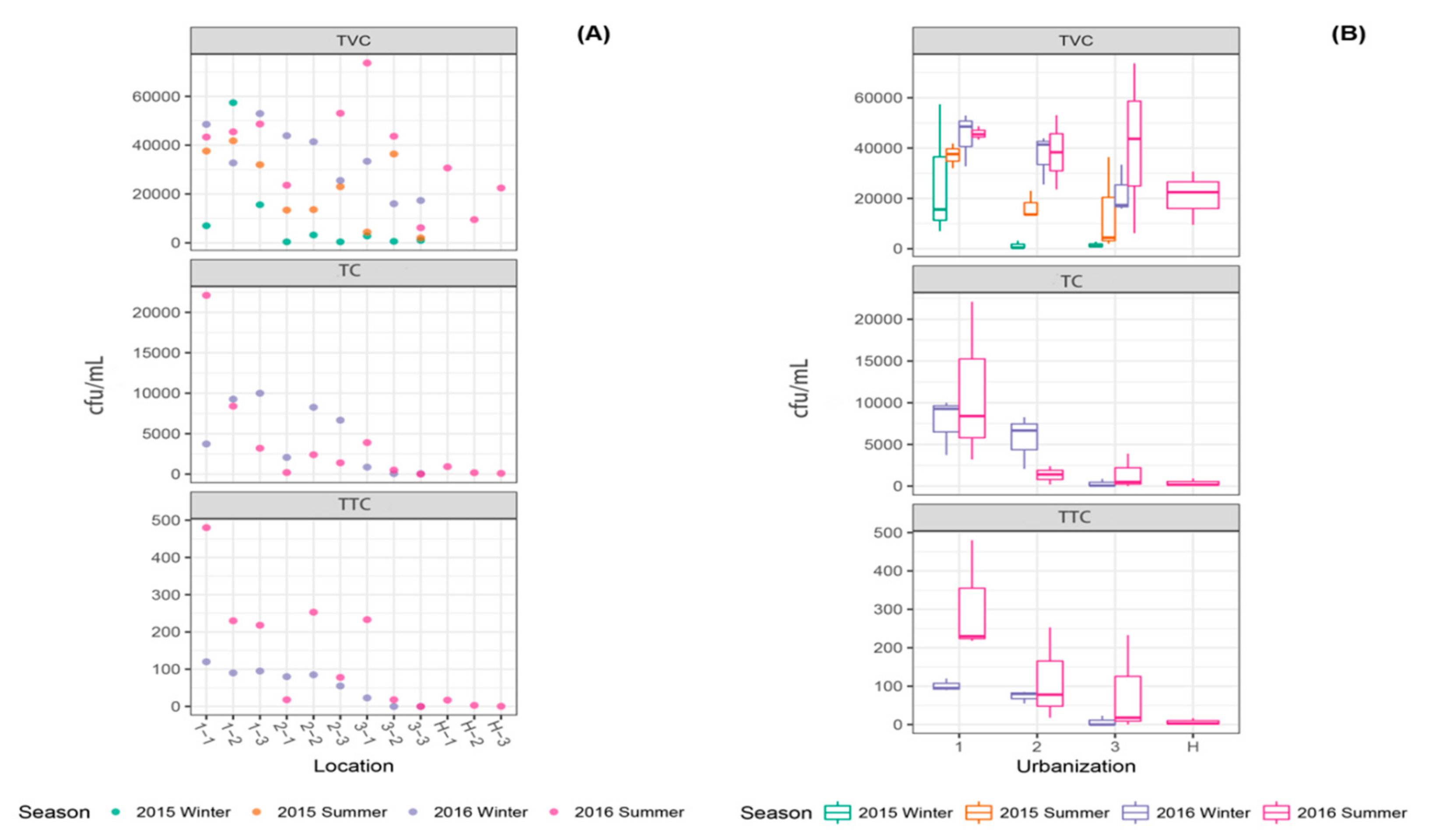
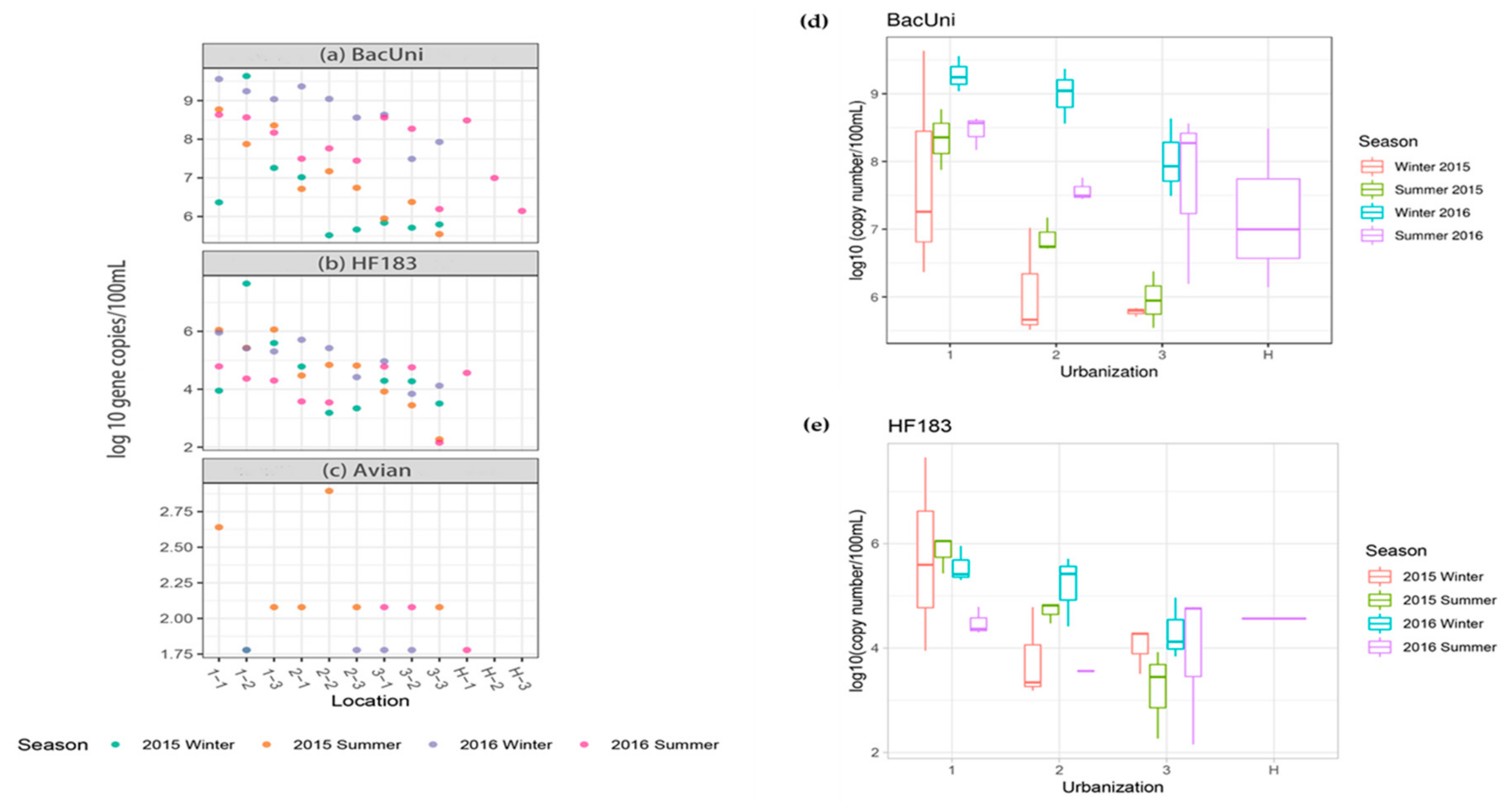
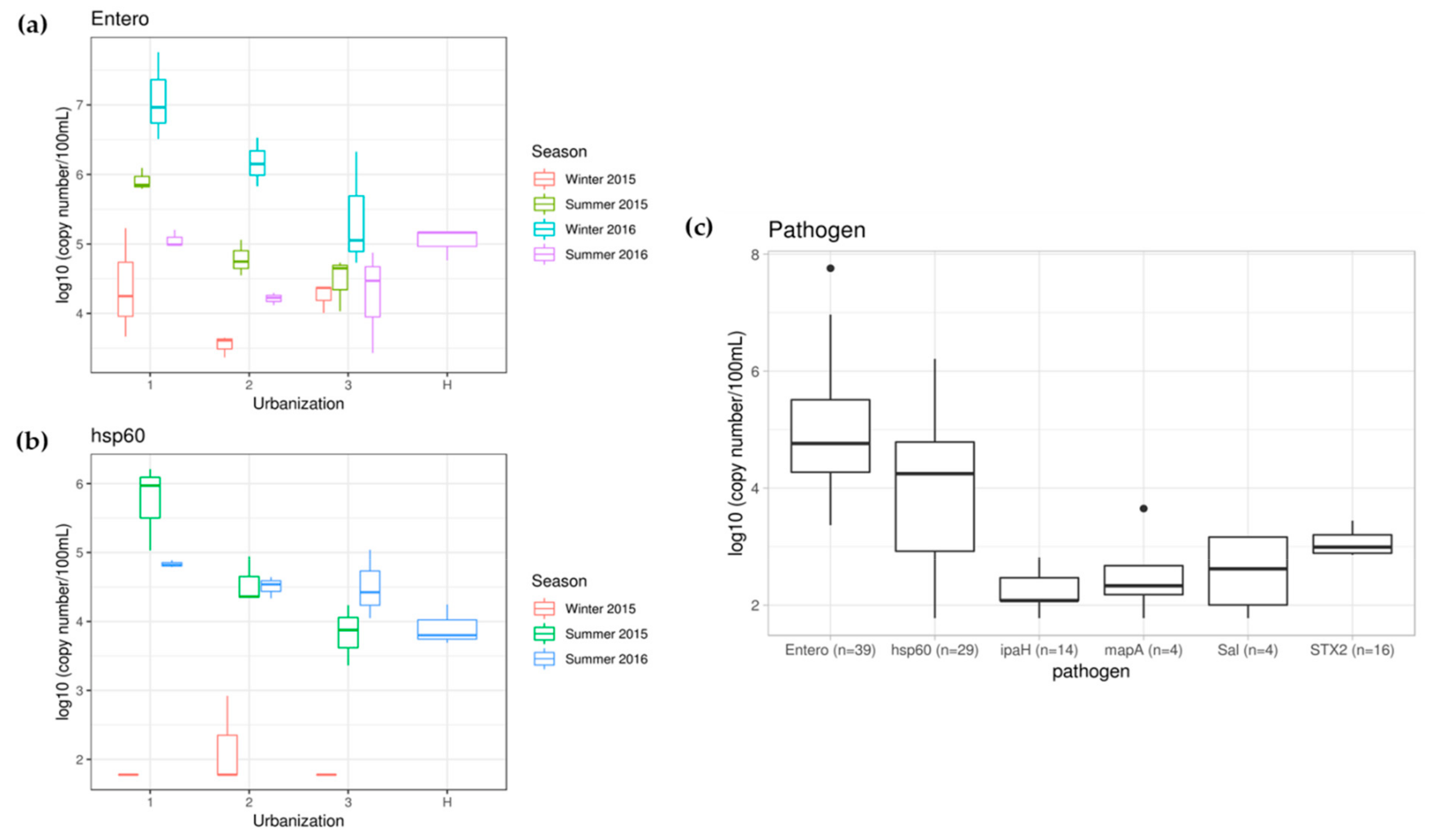
| Parameters | Winter 2015 and 2016 Range (Min-Max) | Summer 2015 and 2016 Range (Min-Max) | Control Location (Huangshan) | p Values | |||||
|---|---|---|---|---|---|---|---|---|---|
| High | Medium | Low | High | Medium | Low | Urbanization | Season | ||
| Water temp. °C | 6–11 | 5.1–9.8 | 5.9–10 | 28–34.1 | 26–33.4 | 28.8–34.4 | 24.3–28.2 | 0.001 ** | <0.001 *** |
| pH | 7.1–7.9 | 7.51–7.9 | 7.58–7.9 | 7.3–7.7 | 7.39–7.86 | 7.3–8.71 | 7.12–8.16 | 0.006 ** | 0.178 |
| Conductivity (µS/cm) | 422–832 | 474–615 | 395–573 | 393–534 | 389–544 | 186–563 | 45.6–146 | 0.013 * | <0.001 *** |
| TN (mg/L) | 2.85–16.5 | 2.14–4.48 | 1.57–4.21 | 2.11–4.67 | 1.92–10.58 | 0.96–4.63 | 0.29–1.17 | 0.001 ** | 0.038 * |
| TP (mg/L) | 0.13–2.10 | 0.07–0.21 | 0.04–0.26 | 0.23–0.53 | 0.12–1.04 | 0.06–0.21 | 0.02–0.06 | <0.001 | 0.102 |
| NO3-N (mg/L) | 1.01–3.42 | 1.13–2.56 | 0.83–2.83 | 0.17–1.01 | 0.05–1.25 | 0.24–1.96 | 0.21–0.92 | 0.816 | <0.001 *** |
| NO2-N (mg/L) | 0.01–0.14 | 0.02–0.08 | 0.01–0.12 | 0.05–0.20 | 0.06–0.35 | 0.03–0.27 | 0.00–0.02 | 0.422 | <0.001 *** |
| PO4-P (μg/L) | 48–497 | 14.37–121.51 | 11.71–46.45 | 92.78–315 | 30.44–117 | 16.11–88.9 | 3.44–28.93 | <0.001 *** | 0.002 ** |
| NH4-N (mg/L) | 1.01–7.84 | 0.18–1.44 | 0.41–1.47 | 0.52–2.40 | 0.23–1.48 | 0.03–2.05 | 0.01–0.10 | <0.001 *** | 0.148 |
| TOC (mg/L) | 1.99–42.3 | 3.17–13.23 | 3.55–13.8 | 3.72–20.8 | 3.75–23 | 3.67–15.6 | 1.31–3.35 | 0.936 | 0.745 |
| Chlorophyll a (µg/L) | 2.33–21.4 | 1.37–15.41 | 1.47-–6.56 | 3.39–68.86 | 2.7–50.177 | 1.95–54.42 | 0.95–3.17 | 0.329 | <0.001 *** |
| Total viable count (× 103 cfu/mL) | 7–57.4 | 0.4–43.9 | 0.6–33.4 | 32–48.7 | 13.4–53.1 | 2–73.7 | 9.5–30.7 | 0.040 * | 0.055 |
| Total coliform count (× 103 cfu/mL) | 3.733–10 | 2.067–8.267 | 0.067–0.867 | 3.2–22.1 | 0.2–2.4 | 0–3.9 | 0.098–0.933 | 0.006 ** | 0.696 |
| Thermotolerant coliform count (cfu/mL) | 90–120 | 55–85 | 0–23 | 218–480 | 18–253 | 0–233 | 0.5–17 | 0.036 * | 0.032 * |
| Sample Type | No. of Samples Tested (n) | No. of Positive Samples a | |||||
|---|---|---|---|---|---|---|---|
| Enterococcus spp. | Arcobacter butzleri (hsp60) | Shigella (ipaH) | Campylobacter (mapA) | Salmonella spp. | STEC (stx2) | ||
| Suzhou | |||||||
| Winter 2015 | 9 | 9 (100%) | 8 (89%) | 2 (22%) | 1 (11%) | 0 | 1 (11%) |
| Summer 2015 | 9 | 9 (100%) | 9 (100%) | 3 (33%) | 0 | 1 (11%) | 0 |
| Winter 2016 | 9 | 9 (100%) | 0 | 2 (22%) | 3 (33%) | 2 (22%) | 7 (78%) |
| Summer 2016 | 9 | 9 (100%) | 9 (100%) | 6 (67%) | 0 | 1 (11%) | 6 (67%) |
| Huangshan | |||||||
| Summer 2016 | 3 | 3 (100%) | 3 (100%) | 1 (33%) | 0 | 0 | 2 (67%) |
| Total | 39 | 39 (100%) | 29 (74%) | 14 (36%) | 4 (10%) | 4 (10%) | 16 (41%) |
© 2019 by the authors. Licensee MDPI, Basel, Switzerland. This article is an open access article distributed under the terms and conditions of the Creative Commons Attribution (CC BY) license (http://creativecommons.org/licenses/by/4.0/).
Share and Cite
Yuan, T.; Vadde, K.K.; Tonkin, J.D.; Wang, J.; Lu, J.; Zhang, Z.; Zhang, Y.; McCarthy, A.J.; Sekar, R. Urbanization Impacts the Physicochemical Characteristics and Abundance of Fecal Markers and Bacterial Pathogens in Surface Water. Int. J. Environ. Res. Public Health 2019, 16, 1739. https://doi.org/10.3390/ijerph16101739
Yuan T, Vadde KK, Tonkin JD, Wang J, Lu J, Zhang Z, Zhang Y, McCarthy AJ, Sekar R. Urbanization Impacts the Physicochemical Characteristics and Abundance of Fecal Markers and Bacterial Pathogens in Surface Water. International Journal of Environmental Research and Public Health. 2019; 16(10):1739. https://doi.org/10.3390/ijerph16101739
Chicago/Turabian StyleYuan, Tianma, Kiran Kumar Vadde, Jonathan D. Tonkin, Jianjun Wang, Jing Lu, Zimeng Zhang, Yixin Zhang, Alan J. McCarthy, and Raju Sekar. 2019. "Urbanization Impacts the Physicochemical Characteristics and Abundance of Fecal Markers and Bacterial Pathogens in Surface Water" International Journal of Environmental Research and Public Health 16, no. 10: 1739. https://doi.org/10.3390/ijerph16101739
APA StyleYuan, T., Vadde, K. K., Tonkin, J. D., Wang, J., Lu, J., Zhang, Z., Zhang, Y., McCarthy, A. J., & Sekar, R. (2019). Urbanization Impacts the Physicochemical Characteristics and Abundance of Fecal Markers and Bacterial Pathogens in Surface Water. International Journal of Environmental Research and Public Health, 16(10), 1739. https://doi.org/10.3390/ijerph16101739






